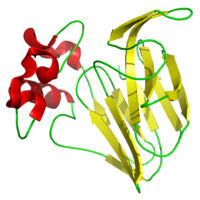
Photo from wikipedia
Protein precipitation, also referred to as protein instability, may lead to haziness in bottled wines and result in significant commercial losses. To avoid problems of this nature, fining finished wines… Click to show full abstract
Protein precipitation, also referred to as protein instability, may lead to haziness in bottled wines and result in significant commercial losses. To avoid problems of this nature, fining finished wines with clay (bentonite) is the most commonly applied methodology. However, bentonite fining reduces yield and may affect wine quality. Protein haze has been primarily linked to grape pathogenesis-related proteins, in particular chitinases and thaumatin-like proteins. To better understand the persistence of these proteins during fermentation, reverse phase chromatography was used to monitor the evolution of total grape proteins as well as of chitinases and thaumatin-like proteins during alcoholic fermentation. The data confirm a previously reported significant decrease in total protein content during fermentation. This reduction in total protein levels was observed throughout fermentation, and was affected by factors such as fermentation temperature, yeast strain or grape cultivar. However, significant changes in the concentration of free chitinases were observed in a yeast strain-dependent manner. The data thus confirm the correlation between the levels of yeast cell wall chitin and changes in chitinase concentration, and suggest that it is primarily the amount of lateral chitin, and not the chitin in bud scars, that is responsible for this activity.
Journal Title: Food microbiology
Year Published: 2019
Link to full text (if available)
Share on Social Media: Sign Up to like & get
recommendations!